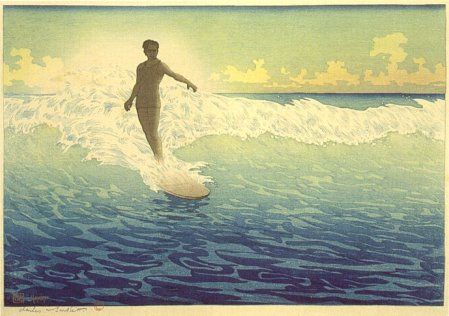Surfing: The Sport of Hawaiian Kings
- Peter T. Young
- 16 de nov. de 2017
- 3 min de leitura

Surfing in Britain
“Surf riding after the Hawaiian fashion is extremely simple when performed with pen and ink, but the swimmer who tries it at Waikiki when there is any sort of sea tumbling in from the south is either overwhelmed in the roller …”
“… or parts company with his board to learn the adamantine solidity of beach sand when a would-be rider essays to plow it up with any portion of his anatomy.” (Paducah Daily Sun, AK, August 18, 1898)
Edward, Prince of Wales (Later King Edward VIII) visited Hawai‘i in April 1920 and enjoyed a three-day surf trip with Earl Mountbatten (future Admiral of the Fleet.) He was so thrilled with the experience that he ordered his ship, the HMS Renown, to return for three days so he could surf again.
But it’s not the surfing of British royals in Hawai‘i that is the focus of this summary, this is about Hawaiian royals in Britain, surfing off the British coast.
While Duke Kahanamoku introduced and promoted surfing to the rest of the world (making him the ‘Father of International Surfing,’) the year he was born (1890,) a couple Hawaiian Princes were riding the waves at Bridlington, Yorkshire in Britain.
Brothers David Kawānanakoa (Koa) and Kūhiō, orphaned after their father died in 1880 and mother in 1884, were adopted by King David Kalākaua’s wife, Queen Kapiʻolani, who was their maternal aunt.
Both were sent on Kalākaua’s ‘studies abroad program.’ They travelled with a guardian arriving in London on November 27, 1889. At first, it was thought that David might work for Hawaii Consul Armstrong in London.
There were 13 Hawaiian Consuls throughout England, indicative of the two countries important trade relations. As for Kuhio, “(he) is not sure if he wants to stay or leave. He thinks he’ll leave, (because) it is very cold here.” (Hall)
On September 22, 1890 Prince Kūhiō could not restrain his enthusiasm in his letter to the Hawaiian Consul Armstrong about their experience of surfing at Bridlington:
“We enjoy the seaside very much and are out swimming every day. The weather has been very windy these few days and we like it very much for we like the sea to be rough so that we are able to have surf riding. We enjoy surf riding very much and surprise the people to see us riding on the surf.”
“Even (John) Wrightson (their tutor) is learning surf riding and will be able to ride as well as we can in a few days more. He likes this very much for it is a very good sport.” (Museum of British Surfing)
Their Bridlington surfboards would most likely have been planks purchased from a boat‐builder. There were extensive regional forests plus readily available foreign timber. A local wood expert’s best guess is that the wood was ash, sycamore or lime. (Hall)
This wasn’t the first international surfing experience for the princely brothers. In 1885, the Koa and Kūhiō (and their other brother Edward, who later died in 1887) were schooled at St Matthew’s Hall in San Mateo, California; they were placed under the care of Antoinette Swan, one of the ‘Pioneers’ of Santa Cruz and daughter of Don Francisco de Paula Marin.
When the Swan home became too crowded, the princes boarded at the nearby Wilkins House, located half a block away, on Pacific and Cathcart streets. (Dunn & Stoner)
The three princes are noted in the first account of surfing anywhere in the Americas: “The young Hawaiian princes were in the water, enjoying it hugely and giving interesting exhibitions of surf-board swimming as practiced in their native islands.” (Santa Cruz Daily Surf, July 20, 1885; Divine)
Another Hawaiian royal may also have added to the international surfing experience. It is suggested that when Princess Kaʻiulani, a cousin of Koa and Kūhiō, also surfed in England (in 1892.)
“She may have been the first female surfer in Britain, … a letter in which she wrote that she enjoyed ‘being on the water again’ at Brighton.”
“Kaʻiulani liked swimming and surfing. She was a high-spirited girl, who when she returned to Hawaii, liked to sneak out past midnight to go swimming in the moonlight with girlfriends.” (Hall)
Reportedly, “The tall foreign dignitary stood erect on a thin board with her hair blowing in the wind and rode the chilly waters.” (British Surfing Museum; Boal)
Follow Peter T Young on Facebook








































Comentários